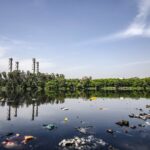
Nanotechnologies for water analysis and treatment

Applications of nanotechnologies for water analysis and treatment
By the AVICENN team – Last updated November 2020
Nanotechnologies are used to develop more efficient methods for water analysis and treatment. It is difficult today to know which applications are already on the market and which are still at the research and development stage.
Three types of use of nanotechnology in the water sector can be identified:
- detection of contaminants in water
- water purification
- decontamination and remediation of soils and waters
In the face of these potential innovations, risks associated with the nanomaterials used must be addressed. This field of application can result in an increase in the presence of manufactured nanomaterials in surface and ground water.
The benefit/risk ratio compared to natural alternatives should also be considered. Innovation needs not be only technological, as evidenced by the “nature-based solutions” (NBS) promoted by the United Nations in 2018.
Detection of contaminants in water
Nanotechnologies could have interesting applications in the detection of chemical and biochemical substances in water. At the beginning of 2011, the General Manager of Veolia Environnement’s Research Centers considered that “it is very probably in this field [of analysis] that we will soon see an industrialization of nanotechnologies for sampling and specific identification in both chemical and microbiological analysis”1Interview of Mr. Hervé Suty, General Manager of Veolia Environnement Research Centers, given to Richard Varrault(Waternunc), published in 2011.
Water purification
Nanotechnologies can be used to desalinate water, filter pollutants, reduce limescale and/or treat wastewater. The processes used or envisaged may combine different types of action:
Filtration of undesirable elements (pollutants, microbes, salt):
This is the most mature process, especially for membranes – the filters can be made up of:
- carbon nanotubes, to extract viruses and bacteria from water
- nanostructured membranes or membranes with added nanoparticles or nanocoatings2See in particular:
– A nanofiltration project to reduce micropollutant discharges from the SOTREMO site has been deployed in Le Mans
– Suez Environnement has participated in a European research project NAMATECH (2009-2012) on the use of nanoparticles for “particularly promising” membranes cf Interview of Mrs. Zdravka Doquang, Head of Analysis and Health at CIRSEE (Suez Environnement), given to Richard Varrault (Waternunc), published in 2011
– Veolia Environnement has set up a partnership with the American company NanoH2O to develop membranes for the desalination of sea water: hydrophilic nanoparticles are added to reverse osmosis membranes to promote the passage of water
– French and American researchers have developed “nanoscopic sieves” cf. Desalinating seawater with nano-scale filters, Laboratoire Interdisciplinaire Carnot de Bourgogne, 29 March 2018
– In 2018, Arkema is proposing an ultra filtration process with a Kynar® PVDF fluoropolymer using nanometric polymer technologies
– in China, in 2018, a promise of industrial production of nanofiber membranes by 3D printing by Nano Sun, read more - attapulgite clay and natural zeolites, available in many parts of the world and having natural pore sizes of nanoscopic size
- nano-sponges that trap contaminants (these can include polyurethane sponges coated with iron oxide nanoparticles or carbon nanotubes and nanosilver)3See for example: – Nanocellulose sponges against oil spills, Industry and Technology, December 9, 2014. Developed by two researchers, Gilles Sèbe of the LCPO at the University of Bordeaux 1 and Philippe Tingaut of the Empa near Zurich, this sponge won the Pollutec Innovative Techniques Award.
–Low energy water purification enabled by nanomaterial-coated sponges, Science for Environment Policy, February 2015 (academic paper: Conducting nanosponge electroporation for affordable and highefficiency disinfection of bacteria and viruses in water, Liu, C et al., Nano Letters, 13(9): 4288-93, 2013).
Chemical dissolution of pollutants by oxidation
This could be done with the use of reactive nanoparticles (titanium, iron oxide for example): nanocatalysts could be used to chemically break down pollutants. For example, titanium oxide nanoparticles are more efficient catalysts than titanium oxide on a macroscopic scale and could be used to destroy contaminants by photocatalysis under UV light.
- At the beginning of 2011, Veolia Environnement was involved in the study of nanoparticles for oxidizing or reducing catalysis to eliminate pollutants in water, with application prospects still uncertain4Interview of Mr. Hervé Suty, General Manager of Veolia Environnement’s Research Centers, given to Richard Varrault (Waternunc), published in 2011: “We can also use TiO2 nanopowders (free or fixed), for photocatalysis and the elimination of pollutants, but also adsorbent nanopowders (activated carbon or others), which will allow selective elimination of certain pollutants by transfer and not by degradation. Here again, we are working with public laboratories as well as industrial manufacturers to develop new technologies and achieve intensive treatment processes. These processes must meet a certain number of performance criteria based on technical and economic considerations, but they must also be part of a sustainable development approach and provide an advantage over current technologies in these areas. The fate of pollutants eliminated with the formation of by-products, for example, but also that of nanoparticles in their implementation are two critical aspects of this research. Typically, in the field of oxidation, which has been studied extensively over the past 30 years with only relative industrial development, nanotechnologies can be used to reposition certain processes in a favorable way by removing obstacles that were previously prohibitive. (…) For nanostructured materials, the gain, the cost/benefit ratio, has not yet been achieved. On the other hand, for materials incorporating nanoparticles, such as membranes in which a powder is dispersed in a polymeric matrix, it is justified, and all the more so if the lifetime of the products is improved. The life of membranes is generally around 5 years, if we can make them last 10 or 15 years it becomes really interesting.”.
- Research has been conducted or is still ongoing:
– at the GEPEA laboratory (Ecole des Mines de Nantes)5Fate of emerging pollutants during a photochemical or photocatalytic treatment under solar irradiation, thesis of Vanessa Maroga Mboula, Ecole des Mines de Nantes, 2012.
– at the European Membrane Institute in Montpellier6See the research projects of the Engineering Department for the elaboration of photocatalytic inorganic membranes of the European Membrane Institute (IEM) of Montpellier (CNRS, UM2, ENSCM) to elaborate membranes based on titanium dioxide nanoparticles in order to develop coupling systems between membrane separation and photocatalytic degradation of pollutants for wastewater treatment.. - Other research is being conducted in many other countries7– Mat baits, hooks and destroys pollutants in water, Rice University, March 2018: “The mat depends on the ability of a common material, titanium dioxide, to capture pollutants and, upon exposure to light, degrade them through oxidation into harmless byproducts”
– Des nanoparticules pour soigner… les cours d’eau et les sols contaminés, Le Soleil (Canada), July 2015
– A nanomaterial to degrade endocrine disruptors, The Journal of the Environment, November 2014.
The extraction of pollutants by magnetization
Magnetic nanoparticles have a large surface area relative to their volume and can therefore easily form chemical bonds with water-borne contaminants – such as arsenic, mercury, lead, oil – and then be extracted with a magnet. Applications are already commercialized and there is a lot of research in this field8See in particular:
– Iranian and Finnish researchers have developed an iron oxide nanoparticle-based method to remove nitrate and nitrite from water: see Scientists Present Simple Method to Eliminate Nitrate, Nitrite from Water, Soil, Iran Nanotechnology Initiative Council, February 2015
– Researchers from Rice University in the United States have used rust nanoparticles (iron dioxide) to extract arsenic from water: see Low-Field Magnetic Separation of Monodisperse Fe3O4 Nanocrystals, Yavuz C T et al. Science, 2006.
In addition, the elimination of bacteria can be performed by using metallic nanoparticles (silver or copper nanoparticles) with antibacterial properties9Cf Research project: NanoSELECT: Biological nanomaterials to purify water, Sweden, FP7; http://www.cordis.europa.eu/result/rcn/165353_en.html and See also: Hymag’in, a French start-up that makes magnetite nanoparticles to purify contaminated water.
Desalination is also an important subject10See in particular
– in the USA in 2017 a research on a combination of membrane distillation and nanophotonics.
– in 2018 a Chinese publication on a method tested in the laboratory, combining the integration of tellurium nanoparticles in water with plasmonics. The rate of water evaporation is multiplied by three under the effect of sun. Thus, in 100 seconds the temperature rises from 29°C to 85°C. The creation of nanoparticles is extremely complex and does not offer any possibility of commercialization at the moment..
Decontamination and remediation
According to a study conducted for Ademe in 2010, the market for decontamination was 470 million euros. One possible solution could be to use iron nanoparticles to clean up the soil. From 2009 to 2012, the NanoFreezes research project mobilized the efforts of researchers from CNRS, INERIS and CEREGE.
Researchers from Gisfi (Groupement d’intérêt scientifique sur les friches industrielles) reiterated in March 2019 the interest of nanoremediation. Several nanomaterials11Such as nano-zeolites, metal oxides, carbon nanotubes and nanofibers, enzymes and various noble metals (mainly bimetallic Fe/Pd or Fe/Pt nanoparticles) and titanium dioxide… have been explored for remediation purposes, but iron nanoparticles remain the most used. They are used to decontaminate water and soil loaded with chlorinated compounds, which are among the most widespread pollutants. They can be injected into the water table and mixed with soils to a depth of a dozen meters. Studies are being funded both in France and Canada12See in particular:
– Studies continue with Gisfi, the Grand Est region and four European partners (Finland, Greece, Hungary and Italy) in a TANIA program TreAting contamination through NanoremedIAtion (€1,285,735 for work from January 2017 to December 2021).
– In Canada, the Institut national de la recherche scientifique (INRS) and the Université de Montréal received a $338,688 grant from the Ministère de l’Économie et de l’Innovation in 2021 for a Innovative nanomaterial-based water decontamination project through the development of new advanced electro-catalytic processes (ECA). .
By using nanocellulose and/or nanochitin membranes, it could be possible to remove bacteria from water13Cf research project: NanoSELECT: Biological nanomaterials to purify water, Sweden, FP7. Similarly, a French start-up is manufacturing and promoting nano-magnetite to treat water and clean up soil. .
However, the authors underline the uncertainties about the risks: “the barriers to overcome are in terms of regulations and the acceptability of these techniques by companies, customers, elected officials and the public“. The introduction of nanoscale ZVIs into the environment may pose a risk to microorganisms that are the basis of the food chain. The factors and processes affecting ecotoxicity are complex and the potential impact of manufactured nanoparticles on the environment and on human health remains poorly described today. In order to prevent any negative impact of nano remediation on the environment, it is essential to conduct an appropriate assessment, including studies with these nanoparticles at the ecosystem scale. It remains essential to impose a benefit-risk analysis.
Any questions or comments? This information sheet compiled by AVICENN is intended to be completed and updated. Please feel free to contribute.
Other news on the topic
Upcoming Nano Agenda

- Webconference for analysis laboratories, plant fertilizer manufacturers and distributors, public authorities…
- Moderated by David Krupka, nanotechnologies development manager at AFNOR Normalisation and Emilie Langlois-Bertrand, nantechnologies standardization project manager.
- In partnership with Armand Masion, CNRS Research Director, and Sandrine Mocoeur, Health, Safety, Environment and Quality Manager at SYNGENTA.
- This exchange will also be an opportunity to explore the creation of a national platform to identify standardization needs.
- Website: www.afnor.org/evenement/nanotechnologies-agriculture-cadre-pratique-responsable/
- 8th Congress of Occupational Medicine and Health (CNMST 2026)
- Theme 5: Emerging pathologies and risks, Mr Henri Bastos (ANSES), Pr Lynda Bensefa-Colas (AP-HP), Dr Catherine Nisse (CHU Lille)
- Website: www.medecine-sante-travail.com
- 20th meeting of the “nano and health” dialogue committee
- Organizer: ANSES
This sheet was originally created in February 2019
Notes and references
- 1Interview of Mr. Hervé Suty, General Manager of Veolia Environnement Research Centers, given to Richard Varrault(Waternunc), published in 2011
- 2See in particular:
– A nanofiltration project to reduce micropollutant discharges from the SOTREMO site has been deployed in Le Mans
– Suez Environnement has participated in a European research project NAMATECH (2009-2012) on the use of nanoparticles for “particularly promising” membranes cf Interview of Mrs. Zdravka Doquang, Head of Analysis and Health at CIRSEE (Suez Environnement), given to Richard Varrault (Waternunc), published in 2011
– Veolia Environnement has set up a partnership with the American company NanoH2O to develop membranes for the desalination of sea water: hydrophilic nanoparticles are added to reverse osmosis membranes to promote the passage of water
– French and American researchers have developed “nanoscopic sieves” cf. Desalinating seawater with nano-scale filters, Laboratoire Interdisciplinaire Carnot de Bourgogne, 29 March 2018
– In 2018, Arkema is proposing an ultra filtration process with a Kynar® PVDF fluoropolymer using nanometric polymer technologies
– in China, in 2018, a promise of industrial production of nanofiber membranes by 3D printing by Nano Sun, read more - 3See for example: – Nanocellulose sponges against oil spills, Industry and Technology, December 9, 2014. Developed by two researchers, Gilles Sèbe of the LCPO at the University of Bordeaux 1 and Philippe Tingaut of the Empa near Zurich, this sponge won the Pollutec Innovative Techniques Award.
–Low energy water purification enabled by nanomaterial-coated sponges, Science for Environment Policy, February 2015 (academic paper: Conducting nanosponge electroporation for affordable and highefficiency disinfection of bacteria and viruses in water, Liu, C et al., Nano Letters, 13(9): 4288-93, 2013) - 4Interview of Mr. Hervé Suty, General Manager of Veolia Environnement’s Research Centers, given to Richard Varrault (Waternunc), published in 2011: “We can also use TiO2 nanopowders (free or fixed), for photocatalysis and the elimination of pollutants, but also adsorbent nanopowders (activated carbon or others), which will allow selective elimination of certain pollutants by transfer and not by degradation. Here again, we are working with public laboratories as well as industrial manufacturers to develop new technologies and achieve intensive treatment processes. These processes must meet a certain number of performance criteria based on technical and economic considerations, but they must also be part of a sustainable development approach and provide an advantage over current technologies in these areas. The fate of pollutants eliminated with the formation of by-products, for example, but also that of nanoparticles in their implementation are two critical aspects of this research. Typically, in the field of oxidation, which has been studied extensively over the past 30 years with only relative industrial development, nanotechnologies can be used to reposition certain processes in a favorable way by removing obstacles that were previously prohibitive. (…) For nanostructured materials, the gain, the cost/benefit ratio, has not yet been achieved. On the other hand, for materials incorporating nanoparticles, such as membranes in which a powder is dispersed in a polymeric matrix, it is justified, and all the more so if the lifetime of the products is improved. The life of membranes is generally around 5 years, if we can make them last 10 or 15 years it becomes really interesting.”
- 5Fate of emerging pollutants during a photochemical or photocatalytic treatment under solar irradiation, thesis of Vanessa Maroga Mboula, Ecole des Mines de Nantes, 2012
- 6See the research projects of the Engineering Department for the elaboration of photocatalytic inorganic membranes of the European Membrane Institute (IEM) of Montpellier (CNRS, UM2, ENSCM) to elaborate membranes based on titanium dioxide nanoparticles in order to develop coupling systems between membrane separation and photocatalytic degradation of pollutants for wastewater treatment.
- 7– Mat baits, hooks and destroys pollutants in water, Rice University, March 2018: “The mat depends on the ability of a common material, titanium dioxide, to capture pollutants and, upon exposure to light, degrade them through oxidation into harmless byproducts”
– Des nanoparticules pour soigner… les cours d’eau et les sols contaminés, Le Soleil (Canada), July 2015
– A nanomaterial to degrade endocrine disruptors, The Journal of the Environment, November 2014 - 8See in particular:
– Iranian and Finnish researchers have developed an iron oxide nanoparticle-based method to remove nitrate and nitrite from water: see Scientists Present Simple Method to Eliminate Nitrate, Nitrite from Water, Soil, Iran Nanotechnology Initiative Council, February 2015
– Researchers from Rice University in the United States have used rust nanoparticles (iron dioxide) to extract arsenic from water: see Low-Field Magnetic Separation of Monodisperse Fe3O4 Nanocrystals, Yavuz C T et al. Science, 2006 - 9Cf Research project: NanoSELECT: Biological nanomaterials to purify water, Sweden, FP7; http://www.cordis.europa.eu/result/rcn/165353_en.html and See also: Hymag’in, a French start-up that makes magnetite nanoparticles to purify contaminated water
- 10See in particular
– in the USA in 2017 a research on a combination of membrane distillation and nanophotonics.
– in 2018 a Chinese publication on a method tested in the laboratory, combining the integration of tellurium nanoparticles in water with plasmonics. The rate of water evaporation is multiplied by three under the effect of sun. Thus, in 100 seconds the temperature rises from 29°C to 85°C. The creation of nanoparticles is extremely complex and does not offer any possibility of commercialization at the moment. - 11Such as nano-zeolites, metal oxides, carbon nanotubes and nanofibers, enzymes and various noble metals (mainly bimetallic Fe/Pd or Fe/Pt nanoparticles) and titanium dioxide…
- 12See in particular:
– Studies continue with Gisfi, the Grand Est region and four European partners (Finland, Greece, Hungary and Italy) in a TANIA program TreAting contamination through NanoremedIAtion (€1,285,735 for work from January 2017 to December 2021).
– In Canada, the Institut national de la recherche scientifique (INRS) and the Université de Montréal received a $338,688 grant from the Ministère de l’Économie et de l’Innovation in 2021 for a Innovative nanomaterial-based water decontamination project through the development of new advanced electro-catalytic processes (ECA). - 13Cf research project: NanoSELECT: Biological nanomaterials to purify water, Sweden, FP7. Similarly, a French start-up is manufacturing and promoting nano-magnetite to treat water and clean up soil.



